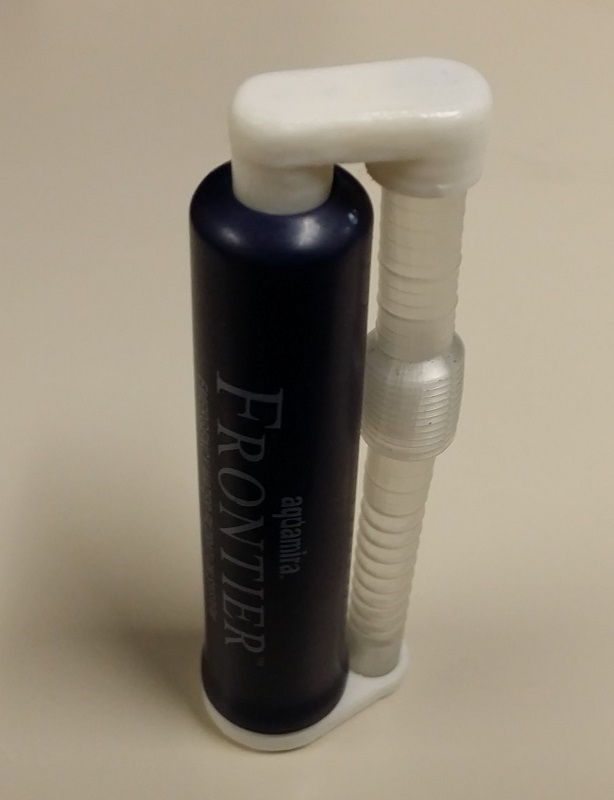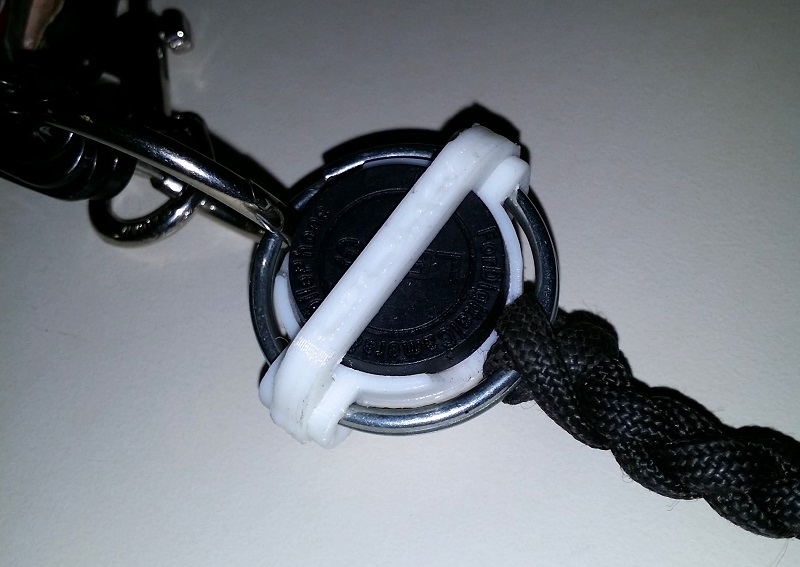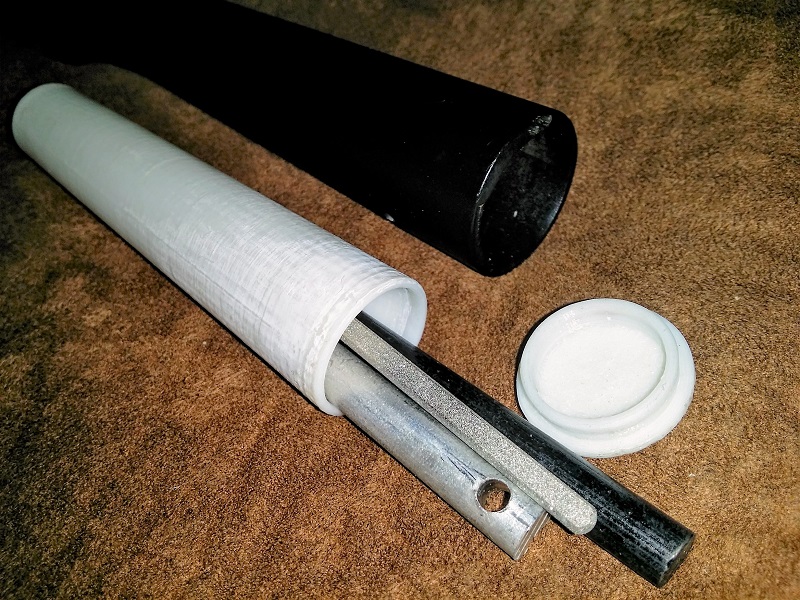#277222 - 10/22/15 06:03 PM
 3D Printer for prepping and survival
3D Printer for prepping and survival
|

Old Hand
Registered: 03/01/07
Posts: 1034
Loc: -
|
Improved my Frontier water straw yesterday by adding two end caps protecting the ends of the filter and straw from dirt, and also making them a single piece for convenience of carrying in the pocket (I hated the straw being longer than the body). It also a lanyard friendly thanks to the snug fit achieved with a bit of hand grinding and polishing. Made of PLA plastic, but if I'll like carrying it that way I'll print it in ABS. See the gallery 
|
|
Top
|
|
|
|
#277225 - 10/22/15 06:57 PM
 Re: 3D Printer for prepping and survival
[Re: Alex]
Re: 3D Printer for prepping and survival
[Re: Alex]
|

Sheriff
Carpal Tunnel

Registered: 12/03/09
Posts: 3871
Loc: USA
|
|
|
Top
|
|
|
|
#277422 - 11/02/15 04:33 AM
 Re: 3D Printer for prepping and survival
[Re: Alex]
Re: 3D Printer for prepping and survival
[Re: Alex]
|

Old Hand
Registered: 03/01/07
Posts: 1034
Loc: -
|
Another one. Actually, printed four. Heavy duty tarp anchor points or fasteners. The two piece device allows you to get a firm hold on any type of textile without puncturing them. Plenty of attachment points on each side. The size could be set to anything you want. I made them large, the side is 2.5". See the full gallery. 
|
|
Top
|
|
|
|
#277425 - 11/02/15 05:00 PM
 Re: 3D Printer for prepping and survival
[Re: Alex]
Re: 3D Printer for prepping and survival
[Re: Alex]
|

Addict
Registered: 03/19/07
Posts: 690
|
Interesting work. One question, if I may - I understand 3D printing is getting increasingly affordable and can be used to make objects of almost any shape or form. However, I'm not really up to date as far as the materials suitable for 3D printing techniques.
Some years ago, when the technology was still in its infancy more or less, I remember that most 3D printers could only work with pretty brittle plastics with very little in the way of structural strength. The finish also tended to be pretty rough. Is it now possible to print directly in ABS? Or something stronger still, maybe reinforced with carbon fiber or the like?
You seem pretty knowledgeable about this stuff so I'd really appreciate some hands on feedback, maybe some basic explanation as how this stuff works in practice. How long does it take to make say, one of those anchor points? And what about the costs involved (other than getting your own 3D printer in the first place)?
|
|
Top
|
|
|
|
#277427 - 11/02/15 06:54 PM
 Re: 3D Printer for prepping and survival
[Re: Tom_L]
Re: 3D Printer for prepping and survival
[Re: Tom_L]
|

Old Hand
Registered: 03/01/07
Posts: 1034
Loc: -
|
There are several dozen of different plastics available for 3D printers at the moment, including water soluble, translucent, rubber like materials, and other exotics. ABS is quite mainstream already, but it requires a printer with the heated bed upgrade, as ABS and other high temperature plastics are not sticking to cold surfaces as required to maintain the printed object position (I have that upgrade already). Strongest parts are usually printed from nylon filament (the grass trimmer line works quite well on a cheap), there are several grades of it though. I have one tested for 4,800 pounds tensile strength. And yes, there are carbon fiber based filaments as well, however they are not that strong, as you cannot use too long fibers to reinforce the plastic mass (like typical 5-10 mm fibers in the CF sewing thread). The strongest filament I know is Stratasys' ULTEM 1010 FDM thermoplastic ( http://www.stratasys.com/materials/fdm/ultem-1010). Used even for external aerospace applications. Expensive. But it will require an all metal filament extruder due to the high melting temperature of it. Most of the consumer grade inexpensive printers are using a PTFE tube for smooth feeding of the filament into the melting zone, so they cannot withstand more than 250C temps. I have ordered such an extruder a while ago, just need to mount it properly on my printer. However, even simple PLA is quite strong for many applications if you take the time and invest it into slow printing speeds and 0.1mm high layers. Surely the geometry of your parts must be well thought out in the first place to properly address mechanical forces applied to them. For very smooth surfaces you may also opt for a specialized filament. Another obvious option would be to simply sand it and coat with some gloss paint (i.e. epoxy spray). With PLA you may opt for an acetone vapor bath if you are about the smooth look only (like making a mask or dinosaur's skull). Otherwise it might eat about 0.5 mm of the piece thickness unevenly. In fact, when I'm making my layers just 0.1mm high, the 0.4mm diameter printing nozzle produces quite smooth surfaces to my liking. They are suitable for a simple mechanics (I've made a perfectly smooth ball bearing using airsoft pellets). The secret for proper printing is that one should always keep in mind that designing parts and devices for printing is quite different from a typical designing for the metalworking (like milling). It's closer to woodcraft, as your parts have layers similar to wood rings. Quite often some sharp knife work will be required if your part was not designed specifically for 3D printing (e.g. you cannot print overhang slopes at less than 45 degree angle without printing lightweight support pillars). Thankfully, the 3D printer modelling community is enormous already: http://www.thingiverse.com/ Most of the objects there could be re-imported for studying, parametric tailoring, or manual modification using free 3D modelling software. All 4 anchors above were printed together on the bed, using a high temp.PLA, in about 5 hours. They are only 25% filled inside, so they are lighter than they look, but every surface, including cord holes, is reinforced with 8 layers (about 2.5mm of solid plastic). All of that is controllable from the printing software, so you can experiment with different settings on the fly. My printer is hidden in the wall cabinet with a power exhaust system and connected to the internet, using Raspberry Pi, so I can monitor (printing temperatures, parameters, and visually on the camera) and control my long prints remotely from my smartphone, tablet, or any PC (my family is instructed how to use a special spatula to remove parts from the bed when they are done baking, and that's the only not automated operation left  ). The longest print I did so far took more than 14 hours. Those are usually overnight jobs. The cost of 3D printing is moderate. If I can buy it off eBay - I don't bother printing it. You can have a good quality 1 kg (35oz) ABS spool for about $25 shipped. That's roughly a 6 month supply at my current pace. Even though ~25% of it goes to the trash bin, as I'm still experimenting a lot (actually, I'm keeping failed test prints, as I plan to build a filament maker some day, which will allow to recycle even PET bottles for printing). The electric power consumption of my average sized printer (RigidBot, 10x10x10" printing space) with ABS temperatures is around 250 watt, with PLA - about 150W on average. At the peak it might be up to 400W. I'm yet to measure the typical print's power cost though (misplaced my KillAWatt device).
|
|
Top
|
|
|
|
#277429 - 11/02/15 10:51 PM
 Re: 3D Printer for prepping and survival
[Re: Alex]
Re: 3D Printer for prepping and survival
[Re: Alex]
|

Old Hand

Registered: 05/29/10
Posts: 863
Loc: Southern California
|
Two questions: First, What's a good 3D modeling and 3D printer drive software? I don't mean modifying existing IGES files, but ground up design.
Second: Is there a media available for lost wax investment casting? Lost wax sand casting (crucible furnace aside) is a relatively low cost/low tech to use stronger mettalics.
_________________________
Hope for the best and prepare for the worst.
The object in life is not to be on the side of the majority, but to escape finding oneself in the ranks of the insane
|
|
Top
|
|
|
|
#277432 - 11/03/15 12:04 AM
 Re: 3D Printer for prepping and survival
[Re: Alex]
Re: 3D Printer for prepping and survival
[Re: Alex]
|

Old Hand
Registered: 03/01/07
Posts: 1034
Loc: -
|
For the printer driving from a PC I'm very pleased with the RepetierHost software It uses the common Cura slicer, or may utilize some others. However, as I'm often using the remote controlled approach, I have the web driven OctoPrint firmware on my Raspberry Pi, connected to the printer. For the free CAD solution I would recommend the DesignSpark Mechanical. It has a lot of professional features, easy to comprehend, has fast growing community, and quite good for a beginner overall. The SolidWorks is ultimate solution, but expensive. I never heard of a 3D printing filament for printing metal casting moulds. Obviously, a typical 3D printer is a relatively low heat system. The closest available is liquid silicone printers, but they are quite different from regular ones (more complex cold liquid extruder is required). But, sure thing, you can use a 3D printed model to make an old school sand or silicone mould for casting. There are completely water soluble filaments available, used for printing pre-assembled things (i.e. a mechanical pen mechanism) in a dual extruder setups (another printer upgrade). Upd: Just found that the cheap PLA is in fact burning out well enough to be used in place of the water soluble filament: http://www.instructables.com/id/How-To-Easy-Sand-Cast-3D-Printed-Objects/ You can define a zero infill and print the model's shell only (0.4 mm thick).
Edited by Alex (11/03/15 12:18 AM)
|
|
Top
|
|
|
|
#277434 - 11/03/15 03:05 AM
 Re: 3D Printer for prepping and survival
[Re: Alex]
Re: 3D Printer for prepping and survival
[Re: Alex]
|

Old Hand

Registered: 05/29/10
Posts: 863
Loc: Southern California
|
For the free CAD solution I would recommend the DesignSpark Mechanical. It has a lot of professional features, easy to comprehend, has fast growing community, and quite good for a beginner overall. The SolidWorks is ultimate solution, but expensive. I never heard of a 3D printing filament for printing metal casting moulds. Obviously, a typical 3D printer is a relatively low heat system. The closest available is liquid silicone printers, but they are quite different from regular ones (more complex cold liquid extruder is required). But, sure thing, you can use a 3D printed model to make an old school sand or silicone mould for casting. There are completely water soluble filaments available, used for printing pre-assembled things (i.e. a mechanical pen mechanism) in a dual extruder setups (another printer upgrade). Thanks for the information about DesignSpark CAD. I've worked with Solidworks, among others, and I've found it good for one-off work. I think something was lost in translation when I asked about casting. It's not the molding material, but a hard, low temperature wax. It's formed into the net shape, embedded in the molding material, and then burned out leaving a perfect cavity for the molten metal. After the metal is poured and cooled, the mold is broken and the part removed. It's used to make metal parts with extremely complex geometry i.e. turbine blades with internal coolant conduits. Up until now, it required assembling individual wax parts to make the wax investment. 3-D printers could manufacture the investment as a single piece if extrudable wax media was available. EDIT: Saw your update. That was the information I was looking for. Thanks. Don't worry about the "investment" nomenclature. Technical terms tend to have very specific meaning that don't necessarily line up with the layman's definition. Get an engineer to explain the difference between load (total external force as a vector), pressure (external force per unit area as a scalar), and stress (internal force per unit area as a vector or a scalar depending on the definition) if you want an example.
Edited by Mark_R (11/03/15 07:49 PM)
_________________________
Hope for the best and prepare for the worst.
The object in life is not to be on the side of the majority, but to escape finding oneself in the ranks of the insane
|
|
Top
|
|
|
|
#277440 - 11/03/15 05:06 PM
 Re: 3D Printer for prepping and survival
[Re: Mark_R]
Re: 3D Printer for prepping and survival
[Re: Mark_R]
|

Old Hand
Registered: 03/01/07
Posts: 1034
Loc: -
|
That's right, being unfamiliar with casting terms you have used ("investment" had only financial meaning to me for example), I had all of the possibilities covered to some extent  (Did you see the update to my message? That's, I think, directly addresses your question).
|
|
Top
|
|
|
|
#277441 - 11/03/15 09:42 PM
 Re: 3D Printer for prepping and survival
[Re: Alex]
Re: 3D Printer for prepping and survival
[Re: Alex]
|

Addict
Registered: 03/19/07
Posts: 690
|
Alex, many thanks for the highly informative reply! Much appreciated, good food for thought. I have a fairly solid background in wood- and metalworking, but this is a whole new ball game. Would love to give it a try one day.
One more question, though - how does a 3D-printed product made of ABS or high-strength thermoplastics compare to an object of identical shape and material manufactured by more conventional technology like injection molding? I'd assume the latter is superior (vastly?) to 3D printing as far as structural strength of the end product?
|
|
Top
|
|
|
|
#277444 - 11/04/15 05:40 AM
 Re: 3D Printer for prepping and survival
[Re: Tom_L]
Re: 3D Printer for prepping and survival
[Re: Tom_L]
|

Old Hand
Registered: 03/01/07
Posts: 1034
Loc: -
|
Anytime, Tom.
For the strength, I believe, it is very close to the injection molding tech. But I understand that my own prints might be quite far from perfect yet. I'm at the very beginning of mastering this process. So far I've printed just about a dozen of useful projects, all of them hold very well under the daily stress (nothing very demanding though), but definitely they have their limits. For example, I had some test prints which were done with some deviations from ideal printing parameters. Their major problem was the delamination of horizontal layers. I'm sure that's the primary weak point of all my prints still. So, when I'm constructing something to withstand a stress, I'm always trying to keep primary force vectors parallel to my slices. Industrial grade printers are calibrated at the factory, and professionals are using filaments with precise properties, which they can input into the software to make necessary adjustments for optimal printing conditions, thus preventing any chance of delamination. Finally, 3D printed plastic parts are widely used in very demanding aerospace tech already, that is something, I think.
|
|
Top
|
|
|
|
#277449 - 11/04/15 06:57 PM
 Re: 3D Printer for prepping and survival
[Re: Alex]
Re: 3D Printer for prepping and survival
[Re: Alex]
|

Old Hand
Registered: 03/01/07
Posts: 1034
Loc: -
|
Designed and printed a simple key chain carrier for the magnetic wide angle and macro lens attachment to my smartphone. The macro lens turns your phone into a quite useful EDC microscope, which has a survival potential, IMO. The original magnetic carrying plate lanyard could not withstand varying forces in my pants' pocket; I almost lost the lens once due to its failure. Also I've noticed that the lens size is close to the split rings' (which I have on both ends of my braided paracord key chain) inner diameter. So, I've decided to exclude another piece dangling from the key ring, but rather embed it right within that ring. Some sanding for smoothing the thing is pending (dark spots are from the attempt to sand the insides with the Dremel's sand band on the rubber mandrel). "Engravings" on the locking piece are the failed attempt to write a text on it (the custom font rendered bad). See the Gallery. And the 3D model (use mouse to rotate and zoom). 
|
|
Top
|
|
|
|
#277451 - 11/05/15 06:19 PM
 Re: 3D Printer for prepping and survival
[Re: Alex]
Re: 3D Printer for prepping and survival
[Re: Alex]
|

Old Hand
Registered: 03/01/07
Posts: 1034
Loc: -
|
Have printed the hollow handle capsule for my Cold Steel Bushman knife. It's basically a thin walled cone with a lip on each end for snap caps. But I had to print several test cones first to get to the exact angle of the handle's inside shape for a truly snug fit. The right length is also important, as at the blade's side opening the handle is squashed somewhat, which starts crushing the capsule if you force it in too far. Still, the inner volume of the capsule is slightly more than 4 inches in length. It sits inside the handle very tightly, so I cannot just shake it out. To remove it you need to press with your finger from the blade side, and it will pop out. But I plan to melt a little piece of plastic into the small side hole in the handle to fix it there semi-permanently. Also I may decide to make it completely waterproof, it's easy to seal both caps with the nail polish over the inner lip. Just as an example I put inside a magnesium stick with small ferro on the side, large plain ferro rod, and a small diamond sharpener. There is plenty more space left inside for maybe some fishing stuff and tinder, at any rate I plan to stuff it tight to prevent any rattling. The Gallery. 
|
|
Top
|
|
|
|
#277751 - 11/28/15 08:30 AM
 Re: 3D Printer for prepping and survival
[Re: Alex]
Re: 3D Printer for prepping and survival
[Re: Alex]
|

Old Hand
Registered: 03/01/07
Posts: 1034
Loc: -
|
Just printed a conic diffuser for my new EDC light. It's very simple, not too long (1" tip), has a square shape at the barrel to stop rolling, and with a little hole in the corner for a lanyard. Works fantastic illuminating the entire room on high. Fits snugly, as I've done multiple hole printing tests a while ago for many round things I plan to 3d print. Needs some sanding inside and outside as usual. On some of the images in the gallery you can see dark horizontal stripes, as the flashlight was blinking on low power settings in sync with the camera's V-sync. 
|
|
Top
|
|
|
|
#278471 - 01/04/16 06:47 PM
 Re: 3D Printer for prepping and survival
[Re: Alex]
Re: 3D Printer for prepping and survival
[Re: Alex]
|

Old Hand
Registered: 03/01/07
Posts: 1034
Loc: -
|
The new 3D printing material just unveiled - a high temp.ceramics: http://www.sciencemag.org/content/351/6268/58.abstractBut that polymer requires laser curing, so a special printer required to print (they are mainstream, but less affordable).
|
|
Top
|
|
|
|
#278585 - 01/06/16 05:49 PM
 Re: 3D Printer for prepping and survival
[Re: Alex]
Re: 3D Printer for prepping and survival
[Re: Alex]
|

Old Hand
Registered: 03/01/07
Posts: 1034
Loc: -
|
Another 3D printed add-on to my 1xAA flashlight. The tripod mount. Experimental, as I've decided to use a 1/4"x20 steel threaded insert (usually used for wood disassemble-able fasteners) instead of 3d printing it entirely (what could allow a much smaller size of that thing). Works great on my aux mini tripod, can support the flaslight without a tripod, and also very convenient in the mouth (I hate biting metal) for hands free flashlight use (the headlamp adapter is in the plans as well, there is a chance I can make it universal out of this mount design). By the way, I've figured I can easily switch the brightness modes with the touch of my tongue! Another sweet feature of that flashlight  The gallery. The gallery.
 By the way, I've decided to use a #8 nylon thread as a lanyard, it is very strong (cannot break it by hands) and allows to hang it over the shirt button or thread through the zipper pull hole easily. The knuckle function of the diffuser is questionable, actually, as I'm not sure how much force it might withstand, should rig a proper target first for testing 
|
|
Top
|
|
|
|
#278607 - 01/07/16 06:31 AM
 Re: 3D Printer for prepping and survival
[Re: Am_Fear_Liath_Mor]
Re: 3D Printer for prepping and survival
[Re: Am_Fear_Liath_Mor]
|

Old Hand
Registered: 03/01/07
Posts: 1034
Loc: -
|
Nice project! Is that for patrolling the sky, or for target imaging? 85mm is too much for the first task (I have experience building bolide patrolling camera) The 3D printing prototyping is a game changer, as you can define and use special settings to save time and filament printing your draft parts. Also the software allows you to slice larger parts and merge components later, so you can test-print fragments of your prototypes i.e. for best fit tuning (by the way, there are certain specifics for tight fittings design of 3D printed parts). At the moment I'm waiting for the Black matte finish ABS filament in the mail to start fiddling with optical attachments to my telescope. So far I've printed several end caps and boxes to my eyepieces, focusers, binoculars, the universal binoculars tripod mount with green laser pointer holder (the later went through 4 prototypes), many other small things (e.g. some weird Lego parts for my DS  ). Another nice project still in the development - the custom high rise stock shoulder pad for my Saiga-12 kushnapup (bullpup) conversion with AK tools capsule holder. To answer your question - see my extended post on that aboveIn short: try to obtain the SolidWorks - truly ultimate solution.
|
|
Top
|
|
|
|
|
|
|
1
|
2
|
3
|
4
|
5
|
6
|
|
7
|
8
|
9
|
10
|
11
|
12
|
13
|
|
14
|
15
|
16
|
17
|
18
|
19
|
20
|
|
21
|
22
|
23
|
24
|
25
|
26
|
27
|
|
28
|
29
|
30
|
31
|
|
|
|
|
|
0 registered (),
656
Guests and
382
Spiders online. |
|
Key:
Admin,
Global Mod,
Mod
|
|
|